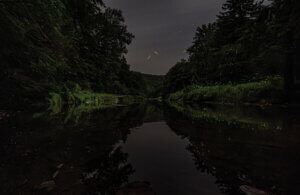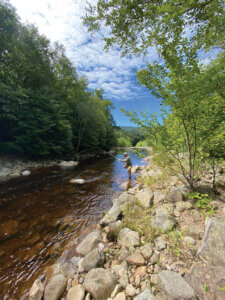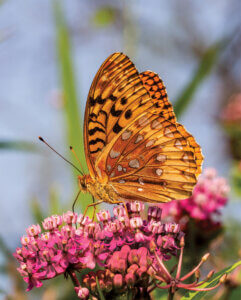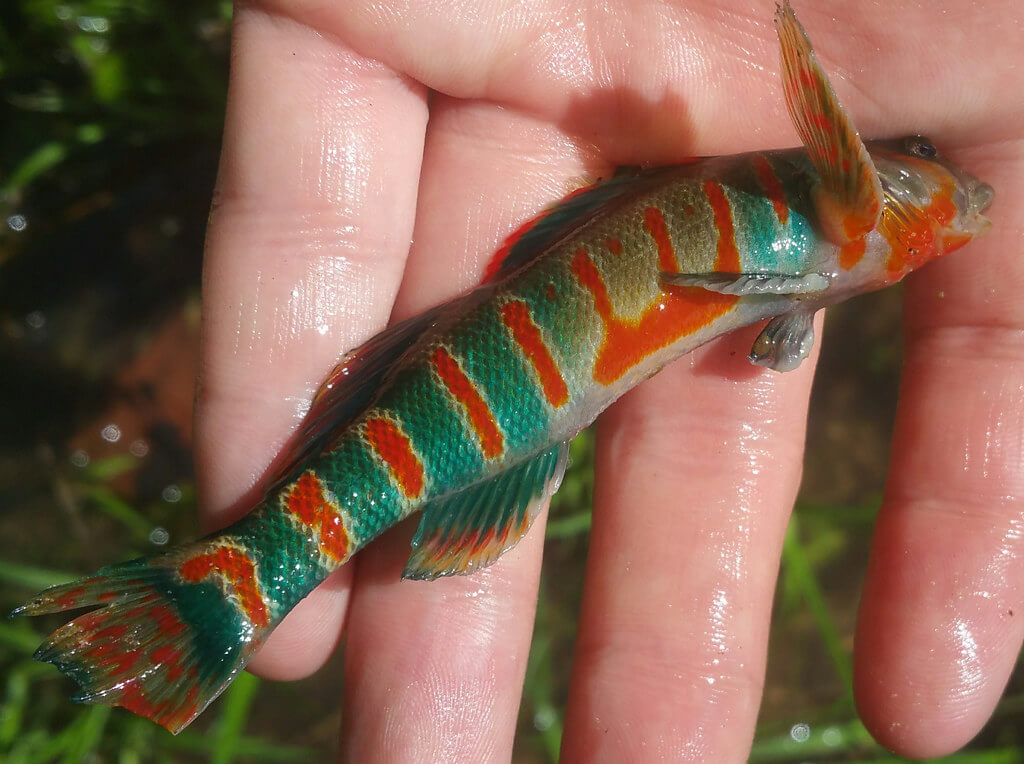
Studies in genetics reveal threats facing unique West Virginia fish species.
Written by Laura J. Roberts
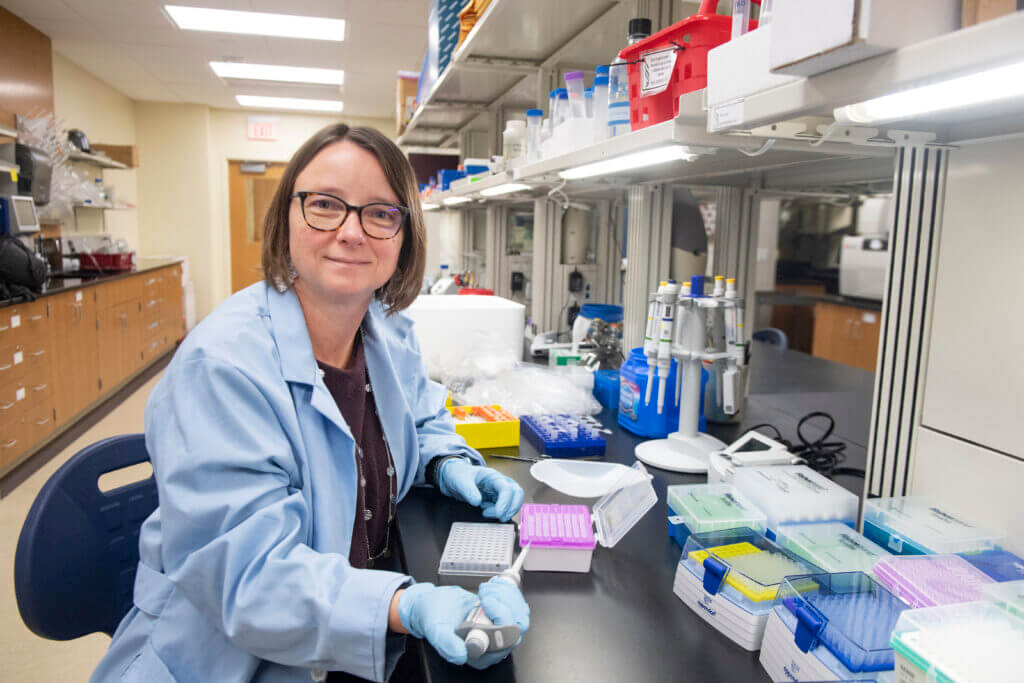
The candy darter isn’t much bigger than a human finger but, what it lacks in size, it makes up for in vibrant color. Found only in certain Virginia and West Virginia streams, this red, orange, and teal fish is an integral part of stream habitat. A middle link in the food chain that eats insects and is in turn eaten by larger fish, the candy darter also serves as a host for freshwater mussel larvae which, when fully grown, help with water quality.
The candy darter thrives in cold, rocky streams. Its range historically covered the Kanawha River watershed, including the New and Gauley rivers. Like many stream dwellers, the candy darter is affected by sedimentation and water quality, so habitat degradation and destruction are significant problems. But its biggest threat has come from the introduction of another darter species: the variegate darter.
The variegate darter is larger than the candy darter and ranges throughout the Ohio River basin. Likely introduced through the disposal of live bait into the water, it outcompetes the candy darter for food and habitat, and its tolerance of warm water makes it less susceptible to the effects of climate change. Even more problematic is the variegate darter’s close relation to the candy darter. The two species can breed and produce a candy–variegate darter hybrid. Fertile offspring continue to reproduce, resulting in the genetic swamping of the candy darter. Its genes are further diluted with each generation, and wildlife geneticists say that the candy darter won’t survive if this hybridization continues.
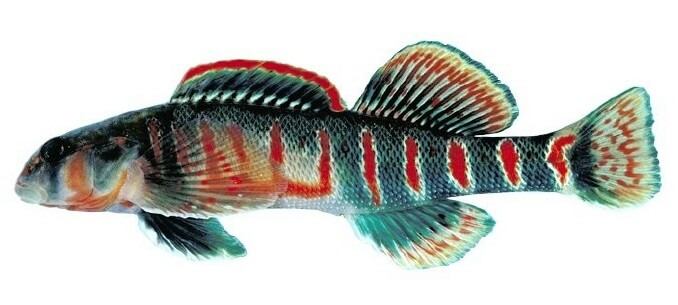
In response, the West Virginia Division of Natural Resources has begun to introduce the candy darter to streams where the variegate darter doesn’t live.
The process is more complicated than simply scooping up fish that have the appearance of the candy darter and transferring them to a new stream. Before they can be released, the DNR must be certain the fish are pure candy darters, without any variegate genes, to prevent the accidental introduction of hybrids into the new population.
Looking Closely
Amy Welsh has been working with the DNR on candy darter conservation efforts. A conservation geneticist at WVU’s Division of Forestry and Natural Resources, she began her career in human forensics before moving on to study lake sturgeon population genetics in the Great Lakes. That’s when she discovered her passion for conservation genetics, a field that applies the tools of genetics to the conservation of species.
“I like genetics from an applied perspective in terms of how it can be used to answer questions that would otherwise be difficult to answer,” Welsh says. While she studies a wide range of taxonomic species, her lab at WVU currently focuses on fish genetics and what the collected data reveals about population structure and trends. She also works with the DNR to monitor the extent and effects of hybridization on West Virginia fish species.
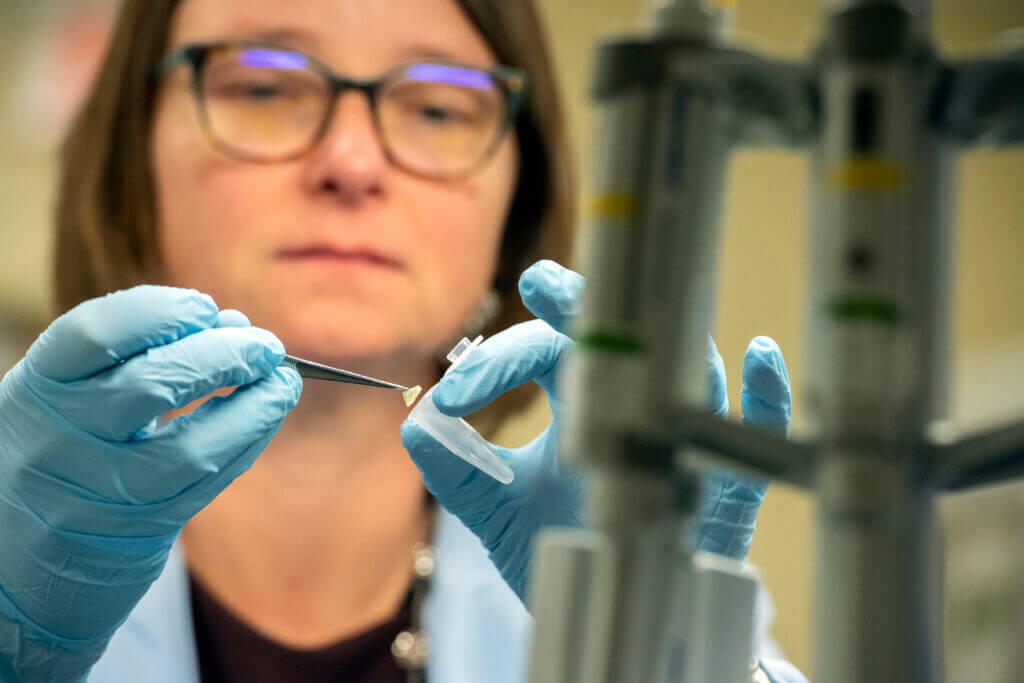
The division’s introduction of the candy darter to variegate darter–free streams has relied on Welsh’s genetics lab to identify pure candy darters. During the fall of 2021, 84 candy darters were collected and screened for variegate darter genetics; only the pure candy darters were released. In addition, Welsh’s lab works with the DNR on hatchery propagation in the spring. At the White Sulphur Springs National Fish Hatchery, candy darters are bred with care to ensure genetic diversity and health before their release into rivers and streams.
The candy darter has historically occurred throughout the Kanawha River system. Out of 35 original populations, 18 now exist. Only five of those are considered healthy. While variegate darters have moved into the Greenbrier and Lower Gauley rivers and hybridized with candy darters, dams have prevented variegate darters from reaching the Upper Gauley and Middle New River. Welsh and the DNR are concerned with the possibility of variegate darters being introduced into these watersheds as live baitfish. Anglers are encouraged to dispose of unused bait into the trash and not the water.
Game Fish
Welsh’s lab also studies game fish species using the same genetic testing techniques applied to the candy darter. Traditionally, the DNR has stocked a strain of walleye from the Great Lakes; now, there’s a focus on stocking the native West Virginia walleye strain.
“We use genetics to identify which strain the walleye came from, or whether it’s a hybrid of the two strains, so that we can tell the DNR, ‘Okay, these individuals are a native strain. These are the ones you want to stock in these locations,'” she says. Using a genetics panel she developed, Welsh can also study walleye population structure and diversity throughout the state to understand how stocking has affected native walleye genetics.
In the case of the native brook trout, conservation genetics helps Welsh understand habitat fragmentation. Impassable culverts in brook trout streams restrict the animals’ movement—the trout cannot swim up or down river, thereby isolating populations from one another. The resulting small populations are at a much greater risk for the loss of genetic diversity than larger ones, and it’s a loss that’s not easy to restore.

“We’ve looked at the effects of culverts and whether culverts are restricting gene flow between populations,” Welsh says. When the problematic culverts were modified and the trout were able to move freely, genetic testing revealed encouraging results.
“In the culverts that have been remediated, we see gene flow restored pretty rapidly,” she says. “It’s really reconnected the systems genetically, which has been cool to see.”
A second brook trout project addresses trout stocking. The DNR hopes to stock native West Virginia brook trout rather than hatchery strains from outside of the state. Welsh’s lab does genetic monitoring and screening to figure out where the hatchery strains are present throughout the state and to be certain the fish going into the rivers are native brook trout.
Welsh says her lab’s next game fish monitoring projects will focus on black bass and muskellunge as work on candy darter and brook trout continues.
A Success Story
While conservation genetics happens at the ground level, wildlife policy is always being assessed on state and federal levels. By coincidence, as Welsh and her students collected genetic data on the candy darter, the species was proposed by conservation groups for listing under the Endangered Species Act.
“That was really an exciting time for us because we thought, ‘Oh, now our genetic data can actually be used to help inform this decision,'” she recalls. “When the candy darter got listed, it was not listed as threatened. It was listed immediately as endangered. And I think the primary reason for that was the extent of hybridization we detected through genetics.” Ultimately, Welsh’s data revealed that few pure candy darters existed in the wild in West Virginia, and it justified the 2018 listing.

In yet another victory, in April of 2021, the U.S. Fish & Wildlife Service declared 368 miles of streams in Virginia and West Virginia as critical candy darter habitat.
Success is born of diligence, and conservation efforts like those directed toward the candy darter can be ineffective without the genetic testing component. Translocating individuals without a clear picture of their genetic makeup is risky—once a hybrid like the candy–variegate darter has been released, the situation is difficult to remedy. Performing the lab work beforehand prevents such mistakes from being made, and Welsh says that the DNR has been excited and proactive about making genetics a priority before moving or introducing any species of fish.
Additionally, her candy darter work may shed light on the fish’s habitat requirements. She hopes that future studies will help biologists restore or create habitat that’s better suited to the candy darter—possibly a shadier environment that cools the water and counteracts the warming temperatures of climate change.
While her research is ongoing, Welsh is grateful for the contribution her lab and her chosen field have made to one of West Virginia’s most unique species. “I would say it’s definitely a conservation genetics success story. Without genetics, they wouldn’t be able to do what they’re doing now for the candy darter.”



